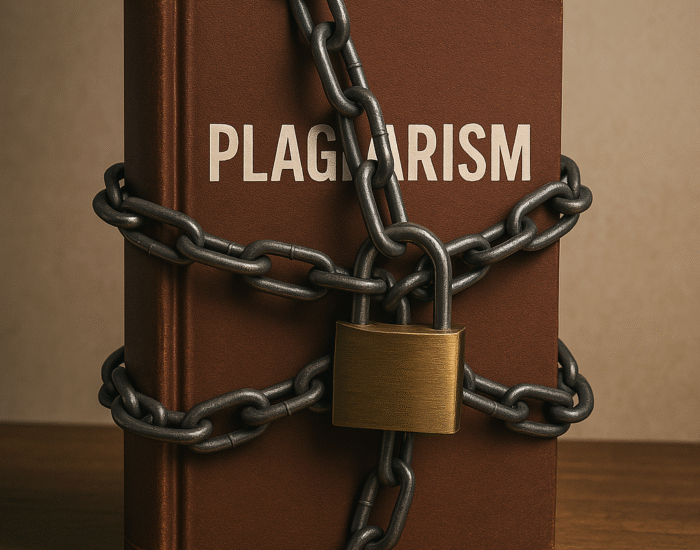Plagiarism. It’s a word that sparks fear in the heart of every student, researcher, and writer. Whether you’re drafting a university paper, submitting a thesis, or writing content for a website, plagiarism is one of the most serious offenses you can commit.
But what exactly is plagiarism? And more importantly, what are the different types of plagiarism you should watch out for?
In this guide, we’ll walk you through the most common (and sneaky) forms of plagiarism, so you can recognize and avoid them in your own work.

What Is Plagiarism?
Plagiarism is the act of using someone else’s work, words, or ideas without giving them proper credit. It doesn’t matter if you copy a whole page or just a sentence—if you present it as your own without citation, it’s plagiarism.
Plagiarism can be intentional (like copying from an article to meet a deadline) or unintentional (like forgetting to include quotation marks or cite a source). Either way, the consequences are the same: academic penalties, damaged reputation, and even legal consequences in some cases.
What are the types of plagiarism?
1. Direct Plagiarism
This is the most obvious and serious type. Direct plagiarism happens when someone copies text word-for-word from a source and passes it off as their own without quotation marks or citation.
Example: Copying the sentence “The mitochondrion is the powerhouse of the cell” directly from a biology textbook and including it in your paper without quotation marks or reference.
Why it’s wrong: It shows a lack of originality, dishonesty, and violates the ethical code of writing.
2. Self-Plagiarism
Yes, you can plagiarize yourself! Self-plagiarism occurs when you reuse your previous work (such as essays, assignments, or research papers) without acknowledgment.
Example: You copy and pasted some or the whole phrases in your previously published paper into your new paper.
Why it’s wrong: Even though the work is yours, presenting it as new and original violates academic integrity.
3. Accidental Plagiarism
This is when you plagiarize without realizing it. It could be due to sloppy note-taking, forgetting to cite a source, or not knowing how to paraphrase.
Example: Writing a paragraph about economic theory that mirrors a source you read last week, without realizing you are using the same structure and ideas.
Why it’s wrong: Intent doesn’t matter—plagiarism is plagiarism.
4. Paraphrasing Plagiarism
This occurs when a writer rewrites someone else’s content in their own words but doesn’t cite the source.
Example: Reading a research article that says, “Urban green spaces have been shown to reduce stress levels,” and writing, “Parks and nature spots help people feel less stressed” without giving credit to the original study.
Why it’s wrong: The ideas are still someone else’s intellectual property.
5. Source-Based Plagiarism
This type includes:
- Citing incorrect sources
- Fabricating sources
- Using a secondary source but citing the original
Example: You read a summary of a famous study in a review paper but you cite review paper instead of the original paper.
Why it’s wrong: It misleads the reader and damages the credibility of your work.
6. Global Plagiarism
This happens when a writer submits someone else’s entire work as their own.
Example: Purchasing a complete research paper from the internet or copying a classmate’s entire essay and submitting it under your name.
Why it’s wrong: It’s the most dishonest and unethical form of plagiarism.
Consequences of Plagiarism (Why plagiarism is bad for students and researchers)
Plagiarism isn’t just unethical—it can be life-altering. Here’s what could happen:
- Academic penalties: Students can fail assignments, courses, or face suspension and expulsion.
- Professional damage: Researchers may have papers retracted, lose grants, or damage their reputation.
- Legal consequences: In cases involving copyright, plagiarism may lead to lawsuits or fines.
- Job loss: Professionals found plagiarizing may be fired or blacklisted in their field.
- Loss of trust: Readers, peers, and supervisors may never trust your work again.
- Missed growth: Plagiarism prevents you from truly learning, reflecting, and building your own voice.
How to Avoid Plagiarism?
Avoiding plagiarism is completely possible with the right habits. Here are a few essential tips:
- Keep clear notes: Distinguish between your ideas and information from sources.
- Always cite: If the idea, phrase, or data isn’t yours, give credit using the correct citation style (APA, MLA, Chicago, etc.).
- Use quotation marks: When using someone’s exact words, enclose them in quotes and cite properly.
- Paraphrase properly: Don’t just change a few words—rewrite ideas fully in your own voice and still cite the original source.
- Use tools (How to detect plagiarism in academic writing): Take advantage of plagiarism checkers, paraphrasing tools, and citation generators to double-check your work.
- When in doubt, cite: It’s always better to over-cite than risk unintentional plagiarism.
How Green Pen Can Help?
At Green Pen, we support students, researchers, and professionals in writing original, high-quality content. Our services include plagiarism checks, proofreading, citation correction, paraphrasing, and full academic writing support.
We understand how easy it is to fall into the trap of plagiarism—especially when you’re stressed, under deadline, or having multiple projects. That’s why we built our services to be fast, ethical, and human-powered.
We don’t just fix your paper; we help you understand what went wrong and how to improve.
Plagiarism comes in many forms—some obvious, some subtle. But every writer has the power to avoid it by understanding the rules, being careful, and seeking support when needed.
If you’re ever unsure, reach out to us at Green Pen. Because at the end of the day, every words matter—and so does your integrity.
Need help checking your paper? Contact us today at www.green-pen.com!

